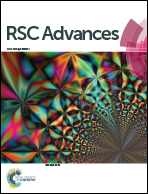Flexible C–Mo2C fiber film with self-fused junctions as a long cyclability anode material for sodium-ion battery†
Abstract
Electrospun carbon fiber films have high contact resistance at the fiber junctions, which causes poor cycling stability and limits their further improvement in energy storage performances. To eliminate the contact resistance of the film, we provide a new strategy to fuse the fiber junctions by introducing MoO2 in the fibers, which replaces the C–C interface by a more active C–MoO2–C interface at the fiber junction to promote mass transfer. MoO2 reacts with C matrix to generate Mo2C and form self-fused junctions during the carbonization process. Due to much lower charge transfer and sodium diffusion resistance, the C–Mo2C fiber film with self-fused junctions shows much better cyclability with capacity retention of 90% after 2000 cycles at a constant current density of 1 A g−1. Moreover, the Mo2C particles provide many electrochemically active sites, leading to additional improvement in sodium storage. The C–Mo2C fiber film has a capacity of 134 mA h g−1 at 1 A g−1 and a high capacity of 99 mA h g−1 even at 5 A g−1.



 Please wait while we load your content...
Please wait while we load your content...